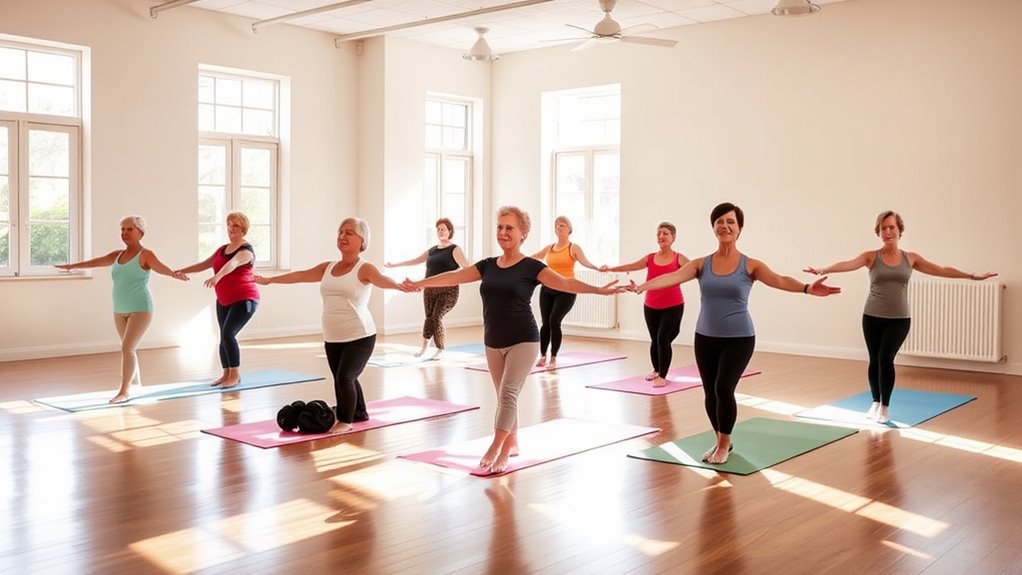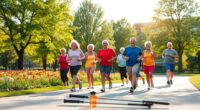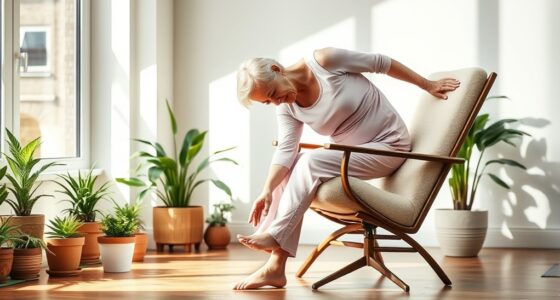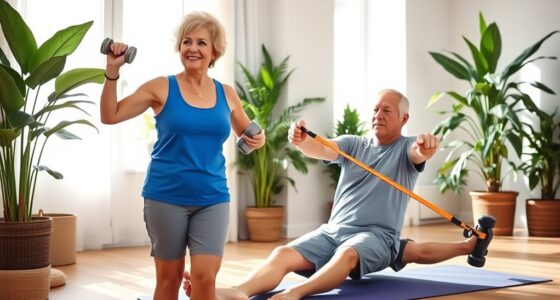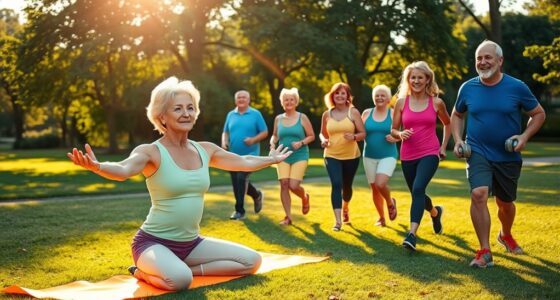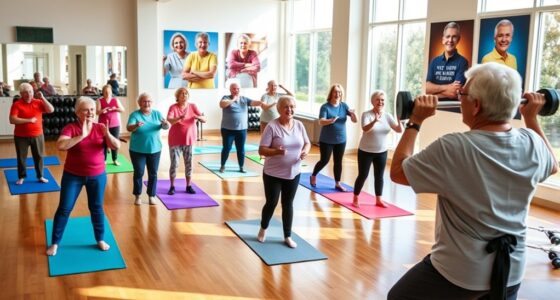Pilates is the perfect low-impact solution for seniors like you, looking to strengthen your core and enhance your overall wellness. It improves mobility, balance, and posture while reducing the risk of falls. You’ll find key exercises, such as the Hundred and Roll-Up, not only easy to do but also highly effective. Plus, adaptable equipment makes it accessible for everyone. If you want to explore the benefits and techniques further, there’s so much more to discover!
Key Takeaways
- Pilates offers low-impact exercises suitable for seniors, enhancing core strength without straining joints.
- Key core exercises include the Plank, Bridge, and The Hundred, effectively engaging all core muscles.
- Equipment like the Reformer and resistance bands can adapt workouts, making them accessible for various fitness levels.
- Regular practice improves balance and stability, reducing the risk of falls and enhancing functional mobility.
- Group classes foster social interaction and motivation, contributing to both physical and mental well-being.
Benefits of Pilates for Seniors
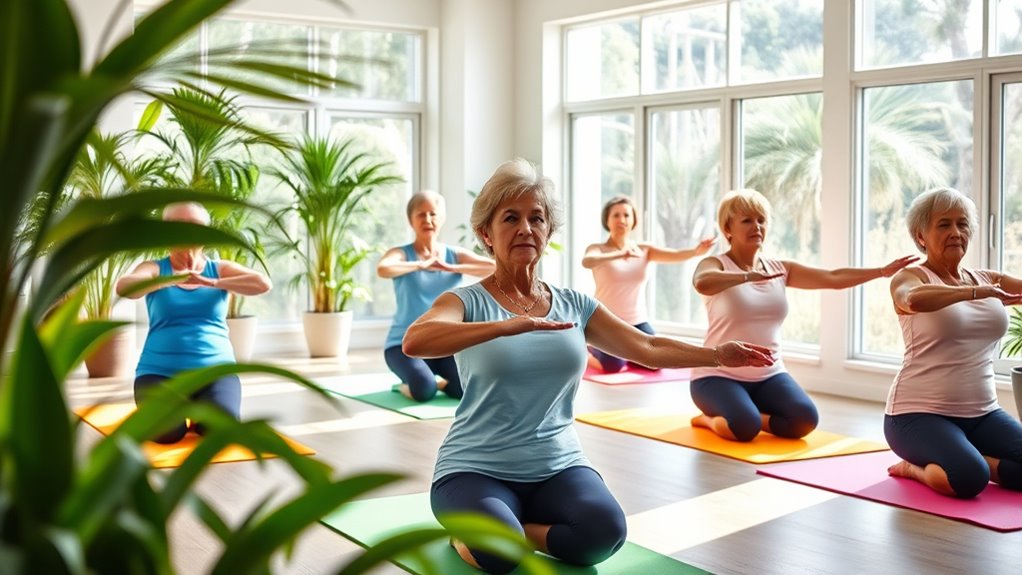
As you age, maintaining your physical and mental well-being becomes increasingly important, and Pilates offers numerous benefits specifically tailored for seniors.
This low-impact exercise improves mobility and joint stability, making daily tasks like climbing stairs easier. By strengthening your core, Pilates enhances posture, which helps prevent joint strain and back pain. It also boosts bone density and notably reduces the risk of falls by improving balance and strength. Additionally, Pilates is a gentle exercise option that is easier on joints compared to other workouts. Incorporating quality mats can further enhance comfort during Pilates sessions. Furthermore, engaging in regular physical activity like Pilates can contribute to enhanced cognitive function, which is vital for maintaining mental sharpness as you grow older. Practicing mindfulness techniques during Pilates can also help in managing stress and enhancing overall well-being. Moreover, the safe sleep guidelines for seniors emphasize the importance of rest and recovery, which can complement the benefits gained from Pilates. Engaging in activities that promote self-fulfillment can further enhance your overall quality of life as you age.
On the psychological side, Pilates promotes relaxation and emotional well-being, contributing to a higher quality of life. Regular practice enhances cognitive function and fosters social interaction in group classes, creating a supportive community.
Key Exercises to Strengthen Your Core
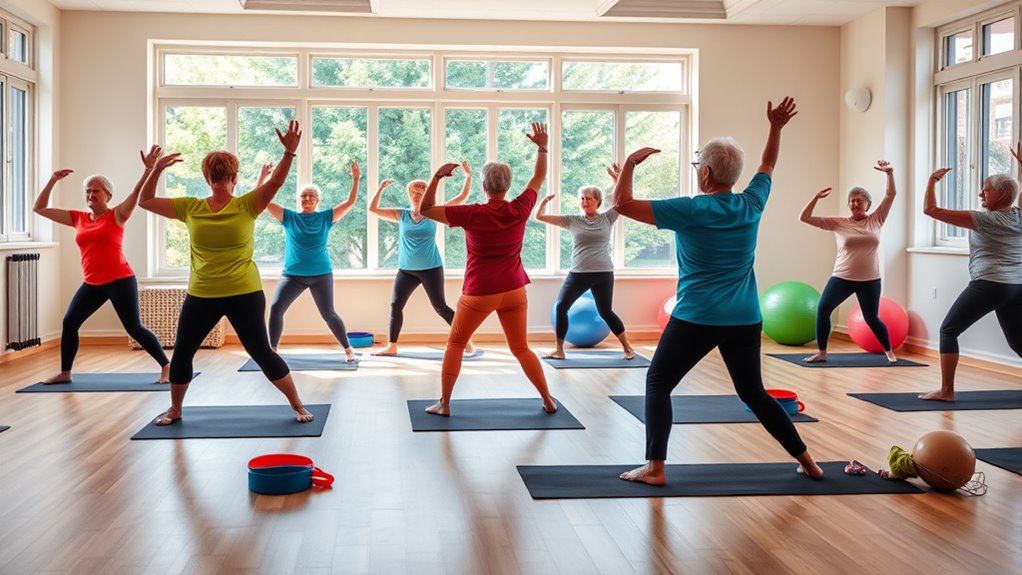
To strengthen your core effectively, incorporating a variety of Pilates exercises is essential.
Start with foundational moves like the Plank and Bridge, which engage your entire core while enhancing stability. The Hundred is great for activating all your core muscles, while the Roll-Up targets your abdominal strength. Core exercises can significantly reduce the risk of falls for seniors, making them a crucial addition to your routine. Additionally, open communication about feelings can foster a positive mindset that encourages regular exercise. Engaging in regular exercise can also help mitigate symptoms of brain fog, which may benefit overall cognitive function. Furthermore, many people find that prophetic dreams can offer insight into their emotional states, potentially influencing their motivation to maintain an active lifestyle. Regular participation in physical activity is linked to overall health, which includes both physical and mental well-being.
For flexibility, try the Saw, which twists and stretches your core. Don’t forget about the Bird Dog and Dynamic Rear Leg Raise; both improve balance and stability.
If you prefer seated exercises, Seated Dead Bugs and Side Bends can help too.
Always prioritize safety by consulting a healthcare professional before starting any new routines, ensuring you choose exercises that fit your abilities and health conditions.
Equipment and Adaptability in Pilates
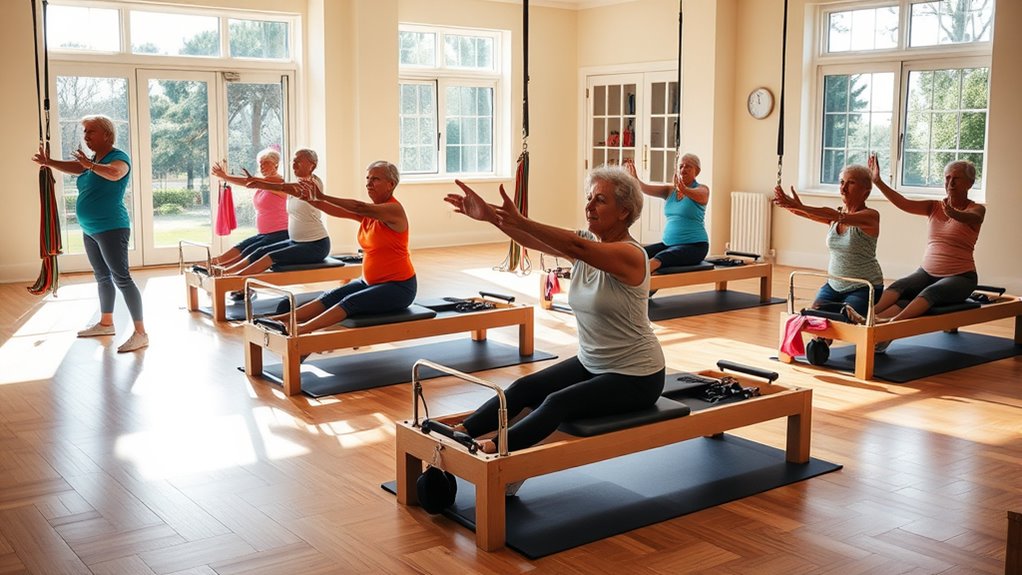
While Pilates equipment can seem intimidating at first, it plays an essential role in enhancing your practice and making exercises more accessible. Incorporating functional design can further improve the accessibility of your workout space for seniors.
The Pilates Reformer, for instance, adjusts resistance to suit your fitness level, allowing you to build strength and flexibility safely. A Pilates mat provides a stable foundation for essential floor exercises, while the Wunda Chair helps develop balance and strength through adjustable springs. Additionally, using Pilates machines helps improve balance, crucial for fall prevention in seniors, through exercises that focus on posture, core strength, and flexibility. The focus on core strength is vital, as strengthening this area can lead to improved overall stability and reduced risk of injury. Incorporating organic juices into your post-workout routine can also aid in recovery and hydration. It’s important to consider the environmental impacts of equipment materials, ensuring they are sourced sustainably to contribute to a cleaner future. User consent management is also essential when utilizing online resources and equipment purchases, ensuring your preferences are respected.
The Cadillac offers versatility for rehabilitation and stability improvement. Resistance bands are lightweight options for enhancing flexibility and strength. Plus, many of these tools are space-efficient, making them perfect for home use.
Always consult a healthcare professional before starting, ensuring your chosen equipment aligns with your specific needs and goals.
Health Benefits That Enhance Quality of Life
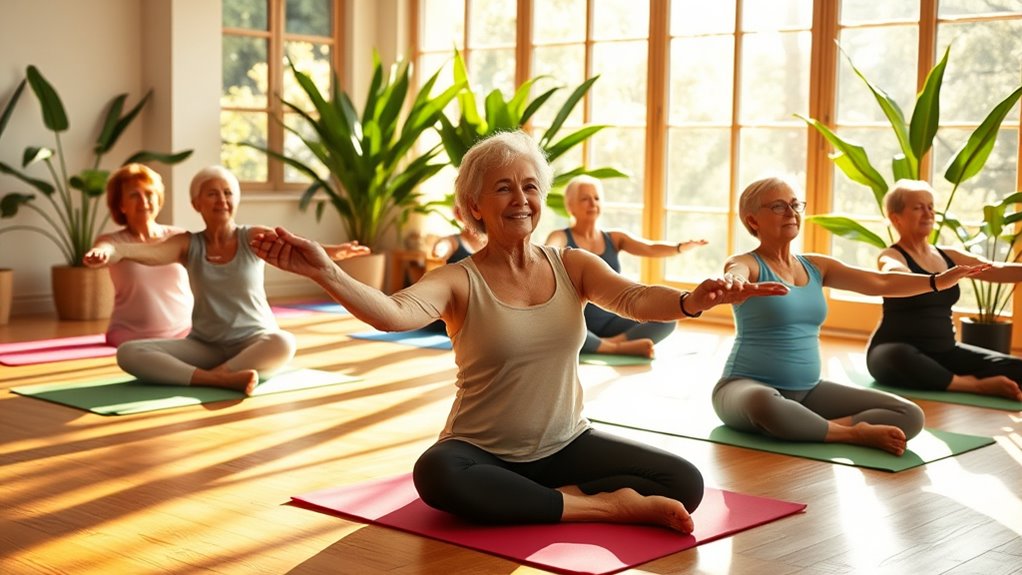
Pilates offers a multitude of health benefits that can greatly enhance your quality of life. By strengthening your core, you not only prevent back and hip pain but also improve your overall stability and posture. This leads to better functional movements and reduces the risk of injuries. Additionally, Pilates emphasizes core strength, which serves as the foundation for explosive movement and overall body stability. Incorporating gentle stretching into your routine can further enhance muscle relaxation and flexibility.
You’ll notice improved mobility and flexibility, making daily tasks easier and helping prevent stiffness. Enhanced balance and coordination gained through Pilates practice greatly lower your risk of falls, boosting your confidence in everyday activities. Engaging in regular physical activity, such as Pilates, can also encourage mindfulness and foster a deeper connection with your body and surroundings. Furthermore, studies suggest that regular physical activity can significantly reduce symptoms of anxiety and depression. Recent studies indicate that AI technologies can also enhance the development of personalized fitness routines by analyzing user preferences and progress. In addition, practicing Pilates aligns with the principle of iterative processes, allowing for continuous improvement in your physical abilities.
Additionally, regular sessions promote physical and mental well-being, reducing stress and enhancing mood. With improved bone health and posture, Pilates truly supports a healthier, more active lifestyle as you age.
Research Supporting Pilates for Older Adults
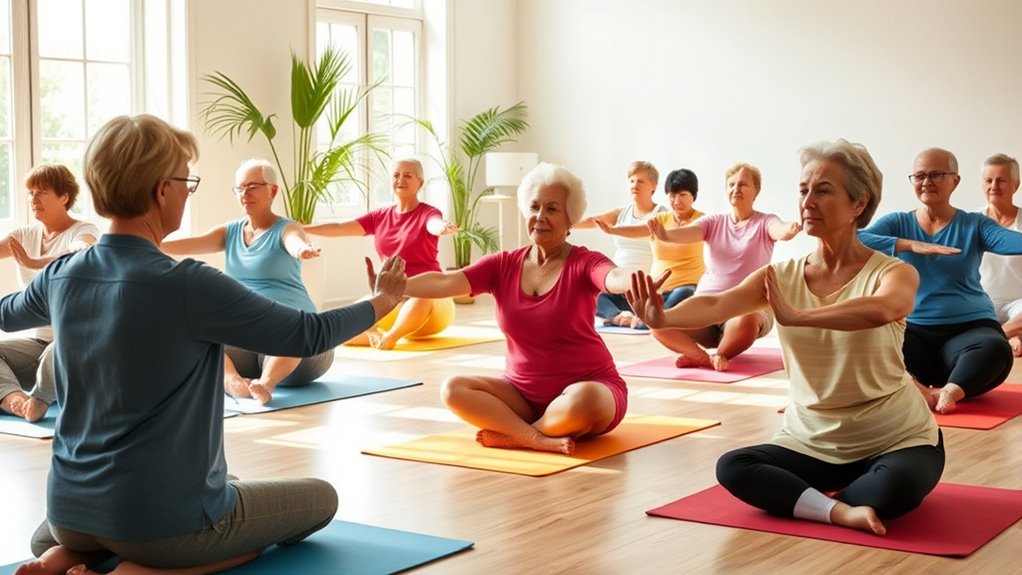
Research shows that Pilates can greatly benefit older adults by enhancing their mobility, balance, and overall well-being. Studies indicate that Pilates improves functional mobility, balance, and gait, which reduces the risk of falls. Since it’s low-impact, you can practice it comfortably even with joint pain. By focusing on core strength, Pilates helps maintain good posture, preventing back pain and hunching as you age. The exercises can be adapted to suit your needs, including chair modifications. In addition, participating in group classes fosters social interaction, enhancing your psychological health. Furthermore, engaging in activities that promote relaxation and joy can further support mental well-being in older adults. While more high-quality studies are needed, existing research highlights Pilates’ effectiveness in improving balance and reducing falls, making it a valuable addition to your fitness routine. Regular practice of Pilates can also lead to improved flexibility, which is beneficial for maintaining a full range of motion in daily activities. Moreover, maintaining consistent routines can support overall stability and well-being in older adults. Additionally, incorporating natural remedies into your wellness routine can complement the benefits of Pilates, promoting holistic health. In fact, many older adults find that regular exercise not only improves their physical health but also enhances their quality of life.
Frequently Asked Questions
How Often Should Seniors Practice Pilates for Optimal Results?
For ideal results, you should aim to practice Pilates 1-2 times a week. This frequency allows you to improve your mobility, strength, and balance without overwhelming your body.
If you’re targeting specific goals, like enhancing core strength or flexibility, consider adding variety to your routine. Always listen to your body and consult a healthcare provider before starting.
Consistency is key, so find a schedule that works for you and stick with it.
Is Pilates Safe for Seniors With Existing Health Conditions?
You might think Pilates isn’t safe if you have existing health conditions, but it can actually be quite beneficial.
Before starting, you should consult your healthcare provider to verify it’s appropriate for you. Pilates is low-impact and can be modified to suit your needs, reducing the risk of injury.
With a qualified instructor, you can safely strengthen your core and improve your overall well-being while enjoying the process.
Can Pilates Help With Arthritis Pain Management?
Yes, Pilates can help with arthritis pain management. You’ll find that it reduces pain by improving joint mobility and strengthening surrounding muscles without putting excessive strain on your body.
The gentle movements enhance flexibility and range of motion, making daily activities easier. Additionally, Pilates promotes a holistic approach, incorporating mindfulness to complement relaxation techniques.
What Should Seniors Wear for Pilates Classes?
When you step onto the mat, think of your attire as your trusty armor. For Pilates classes, you should wear comfortable, form-fitting clothes that let you move freely.
Breathable fabrics are a must to keep you cool. Opt for moisture-wicking tops and stretchy bottoms like leggings or capris. Avoid baggy pants that could trip you up.
Are There Online Pilates Classes Suitable for Seniors?
Yes, there are plenty of online Pilates classes suitable for you as a senior.
Platforms like Pilates Anytime and SilverSneakers offer beginner-friendly, low-impact workouts that cater to various fitness levels. You can choose from mat, chair, or even standing Pilates classes, all designed to enhance core strength and improve balance.
Plus, many classes include modifications to guarantee you stay safe while exercising, making it easier for you to enjoy the benefits of Pilates at home.
Conclusion
Incorporating Pilates into your routine is like discovering the fountain of youth for your core strength. With its gentle yet effective exercises, you’ll not only build stability but also enhance your overall quality of life. As you flow through each movement, you’ll feel more agile and connected to your body, much like a graceful dancer. So, why not embrace this transformative journey? Your stronger, more vibrant self is just a class away, ready to dance through life with ease.
